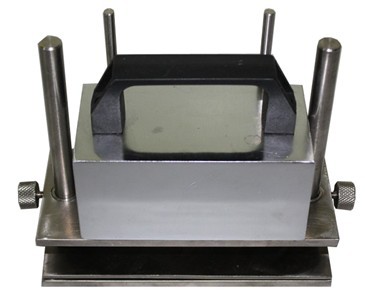
Perspirometer
Colour Fastness of dyed or printed fabrics against perspiration is determined by exposing the fabric sample to the action of both alkaline and acidic reagents while in contact with undyed adjacent fabrics is placed between plastic plates under a fixed load inside an oven maintained at 370 centigrade. The apparatus used for this test is called the Perspirometer.
consists of a number of acrylic plates and which can be kept in suitable loading frame. The loading frame consists of two steel plates between which the acrylic plates placed. The test specimen are stitched between suitable white cloth pieces and dipped in either alkaline or acidic test solutions. The composite sample is placed in between any two acrylic plates. A number of test specimens can be loaded simultaneously between different sets of acrylic plates by stacking them one above the other. Loading is done by keeping a standard dead weight on top of the upper plate assembly, which consists of two parallel plates separated by suitable compensating springs. The guide rod attached to top plate of this assembly is locked while under load and the load removed. The springs compensate for subsequent variations in load due to variation in thickness of the test specimens on drying.
The test is continued for the required time under the specified condition of temperature. After this the samples are removed from the frame and dried. The degree of staining of the while pieces of cloths and change in colour of the test specimens are evaluated using Grey Scales and compared against standard rating cards.
All the components are made of stainless steel and are finished in black stoving enamel paint to give them a corrosion resistant finish.
RELATED SPECIFICATIONS :
IS 1971 - 1983
Method of Determination of Colour Fastness of Textile materials to Perspiration.
AATCC 10
Method of Test for Colour Fastness to Perspiration.
Colour Fastness of dyed or printed fabrics against perspiration is determined by exposing the fabric sample to the action of both alkaline and acidic reagents while in contact with undyed adjacent fabrics is placed between plastic plates under a fixed load inside an oven maintained at 370 centigrade. The apparatus used for this test is called the Perspirometer.
consists of a number of acrylic plates and which can be kept in suitable loading frame. The loading frame consists of two steel plates between which the acrylic plates placed. The test specimen are stitched between suitable white cloth pieces and dipped in either alkaline or acidic test solutions. The composite sample is placed in between any two acrylic plates. A number of test specimens can be loaded simultaneously between different sets of acrylic plates by stacking them one above the other. Loading is done by keeping a standard dead weight on top of the upper plate assembly, which consists of two parallel plates separated by suitable compensating springs. The guide rod attached to top plate of this assembly is locked while under load and the load removed. The springs compensate for subsequent variations in load due to variation in thickness of the test specimens on drying.
The test is continued for the required time under the specified condition of temperature. After this the samples are removed from the frame and dried. The degree of staining of the while pieces of cloths and change in colour of the test specimens are evaluated using Grey Scales and compared against standard rating cards.
All the components are made of stainless steel and are finished in black stoving enamel paint to give them a corrosion resistant finish.
RELATED SPECIFICATIONS :
IS 1971 - 1983
Method of Determination of Colour Fastness of Textile materials to Perspiration.
AATCC 10
Method of Test for Colour Fastness to Perspiration.
Main Products
Tester-textile testing equipments, toy testing equipments etc.
